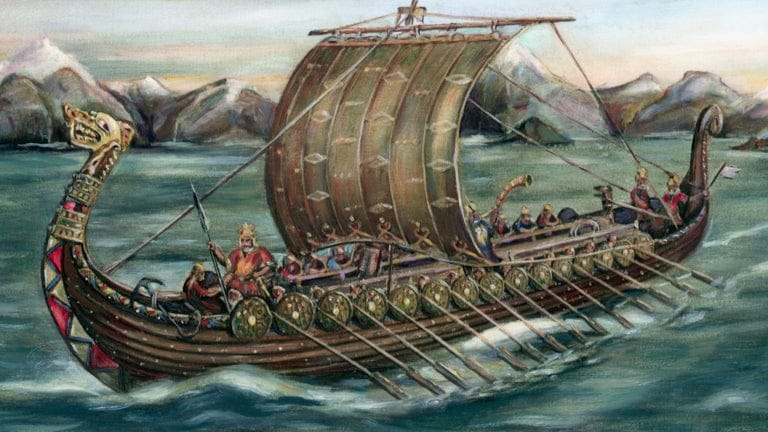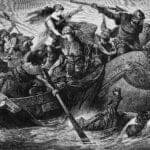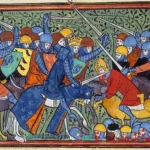The Viking Age, spanning roughly from the late 8th to the 11th centuries, left an indelible mark on the history and development of Europe. While often remembered for their fierce warriors and maritime prowess, the Vikings also instigated significant social, economic, and religious transformations. One of the most impactful aspects of the Viking Age was their raids on monasteries, which sent shockwaves through medieval society and left a lasting legacy on the religious landscape of Western Europe.
How Did the Viking Invasion Affect the Monasteries?
Before the Vikings set their sights on the shores of Western Europe, monasteries were generally perceived as places of sanctuary and peace, relatively untouched by the conflicts of the outside world. However, the arrival of the Vikings shattered this tranquility, exposing the vulnerability of these religious institutions and forever altering the perception of safety and security.
The raid on Lindisfarne in 793 AD stands as a chilling testament to the Vikings’ audacity and the vulnerability of monastic communities. This event, recorded with a mix of terror and awe by contemporary chroniclers, sent shockwaves across Europe. Lindisfarne, located on a remote island off the coast of Northumbria, was revered as a center of learning and piety. The Vikings’ attack on this sacred site signaled that no place, no matter how isolated or holy, was safe from their reach.
There were several reasons why monasteries became prime targets for Viking raids. Firstly, monasteries were repositories of significant wealth. Donations from wealthy patrons, coupled with the monasteries’ own economic activities, often resulted in the accumulation of gold, silver, and other precious objects. These treasures made monasteries attractive targets for the Vikings, who sought material gain from their raids.
Secondly, monasteries housed valuable religious relics, which held immense spiritual significance in medieval society. Vikings often seized these relics to ransom back to the religious communities or to sell to other interested parties. The theft of these sacred objects not only deprived monasteries of their spiritual treasures but also served as a powerful symbol of the Vikings’ disregard for Christian authority.
Thirdly, monasteries were centers of learning and literacy in a time when these skills were largely confined to the clergy. Vikings recognized the strategic value of disrupting these centers of knowledge. By attacking monasteries, they not only looted them of their treasures but also disrupted the transmission of knowledge and weakened the Church’s influence in society.
The impact of Viking raids on monasteries was devastating. The loss of life, destruction of property, and theft of valuable artifacts were just the tip of the iceberg. The psychological impact of these raids was arguably even more profound. The Vikings’ attacks challenged the very foundations of medieval society, shaking the faith of many in the Church’s ability to provide protection and spiritual guidance.
How did Vikings affect monasteries?
The Vikings’ impact on monasteries was multifaceted and far-reaching. Their raids not only resulted in immediate destruction and loss but also forced these religious institutions to adapt and evolve in response to the new realities of the Viking Age.
Plunder and Destruction – A Closer Look
Viking raids were often swift and brutal, leaving a trail of destruction in their wake. Monks were frequently killed, taken hostage for ransom, or sold into slavery. The Vikings’ disregard for the sanctity of monastic life shocked and terrified their victims, further amplifying the psychological impact of their attacks.
Beyond the human cost, the destruction of monastic libraries and scriptoria resulted in the loss of countless manuscripts, books, and historical records. This cultural devastation represented a significant setback to the preservation and transmission of knowledge in medieval Europe. The Vikings’ actions, whether driven by a desire for wealth or a disregard for Christian beliefs, had a profound impact on the intellectual landscape of the time.
Danegeld: Paying for “Protection”
Faced with the constant threat of Viking raids, some monasteries resorted to paying Danegeld, a form of tribute, in exchange for promises of peace. While this strategy might have provided temporary respite, it came at a heavy price. Paying Danegeld drained monastic coffers, diverting resources away from charitable works, education, and the maintenance of the monasteries themselves. The practice also served to embolden the Vikings, demonstrating that their aggression could be financially rewarding.
The Long Shadow of Viking Raids
The impact of Viking raids on monasteries extended far beyond the immediate destruction and disruption. Many monasteries were forced to relocate further inland, abandoning their traditional homes and agricultural lands in search of greater safety. This displacement disrupted monastic life and led to the loss of valuable resources.
Moreover, the psychological scars left by the Viking raids ran deep. The fear of attack loomed large, leading to increased fortifications and a greater emphasis on defense in monastic architecture. This shift towards militarization reflected the changing times and the need for monasteries to adapt to the realities of the Viking Age.
It is important to acknowledge that our understanding of the Viking Age is constantly evolving. Archaeological discoveries, reinterpretations of historical texts, and ongoing scholarly debates continue to shed light on this complex period. The Vikings’ motives, the extent of their impact, and the long-term consequences of their actions are still subjects of active investigation and discussion.
Why did Vikings raid monasteries?
The Vikings’ motives for raiding monasteries were complex and multifaceted, likely encompassing a combination of economic, strategic, and potentially even religious motivations.
1. Monasteries were Wealthy and Vulnerable:
- Yes: Monasteries, often enriched by donations and their own economic activities, possessed significant wealth in the form of gold, silver, religious artifacts, and landholdings.
- Furthermore: Many monasteries were located in isolated areas, making them easy targets for Viking raiders seeking to minimize resistance and maximize their gains.
- Therefore: The combination of wealth and vulnerability made monasteries attractive targets for Vikings seeking to acquire riches and resources.
2. Strategic Advantage:
- Yes: Attacking monasteries allowed the Vikings to disrupt the social and economic structures of Christian communities, weakening their rivals and consolidating their own power.
- Moreover: Raiding monasteries could also serve as a means of projecting power and instilling fear, further solidifying the Vikings’ reputation as a force to be reckoned with.
- Hence: The strategic advantages of targeting monasteries likely played a significant role in the Vikings’ decision-making.
3. Religious and Cultural Differences:
- Yes: While not the sole motivator, religious differences may have played a role in the Vikings’ willingness to target monasteries. As adherents to pagan beliefs, the Vikings may have viewed Christian monasteries as symbols of a rival religion, making them more susceptible to attack.
- However: It’s crucial to avoid oversimplifying the Vikings’ motivations as solely driven by religious animosity. The evidence suggests that economic and strategic considerations were likely the primary driving forces behind their raids.
- Therefore: While religious differences may have been a contributing factor, it’s essential to consider the broader context of the Vikings’ actions and avoid attributing them solely to religious zealotry.
In conclusion:
The Vikings’ raids on monasteries were complex events with far-reaching consequences. While motivated primarily by economic and strategic considerations, these raids had a profound impact on the religious, cultural, and intellectual landscape of medieval Europe. The Vikings’ actions forced monasteries to adapt, contributing to the evolution of monastic life and leaving an indelible mark on the history of Western civilization.
















